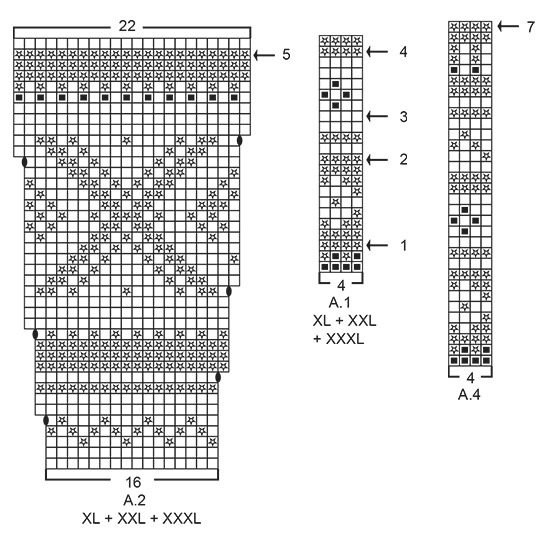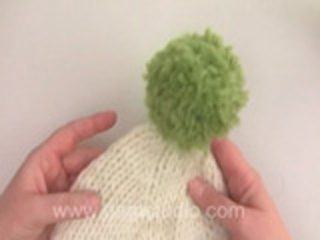Narvik |
||||||||||||||||
 |
 |
|||||||||||||||
The set consists of: Knitted sweater with round yoke, multi-colored Nordic pattern and A-shape, worked top down. Sizes S - XXXL. Hat with multi-colored Nordic pattern and pom pom. The set is worked in DROPS Karisma.
DROPS 183-2 |
||||||||||||||||
|
INFORMATION FOR THE PATTERN: INCREASE/DECREASE TIP: To work out how to increase or decrease evenly, count the total number of stitches on the needle (e.g. 96 stitches) and divide by the number of increases/decreases to be made (e.g. 28) = 3.4. In this example, increase by making 1 yarn over alternately after each 3rd and 4th stitch. On the next round knit the yarn overs twisted to prevent holes. If you are decreasing, knit alternately approx. every 3rd and 4th stitch and every 4th and 5th stitch together. ELEVATION (for back of neck on sweater): Insert 1 marker at the beginning of the round = mid back. Start from the right side with wine red and knit 12-13-14-15-16-17 stitches past the marker, turn, tighten the strand and purl 24-26-28-30-32-34 stitches. Turn, tighten the strand and knit 36-39-42-45-48-51 stitches, turn, tighten the strand and purl 48-52-56-60-64-68 stitches. Turn, tighten the strand and knit 60-65-70-75-80-85 stitches, turn, tighten the strand and purl 72-78-84-90-96-102 stitches. Turn, tighten the strand and knit back to mid back. PATTERN: Sweater: See diagrams A.1 to A.3. Choose diagram for your size. Hat: See diagrams A.3 and A.4. The whole pattern is worked in stockinette stitch. KNITTING TIP: To avoid the knitting gauge becoming tighter when working pattern, it is important that the strands do not pull at the back of the piece. You can increase a needle size when working pattern if this is a problem. INCREASE TIP (for sides of body): Start 2 stitches before the marker thread, make 1 yarn over, knit 4 (the marker thread sits in the middle of these 4 stitches), make 1 yarn over (= 2 stitches increased). On the next round knit the yarn overs twisted to prevent holes. DECREASE TIP (for mid under sleeve): Start 3 stitches before the marker thread, knit 2 together, knit 2 (the marker thread sits in the middle of these 2 stitches), slip 1 stitch as if to knit, knit 1, pass the slipped stitch over the knitted stitch (= 2 stitches decreased). ---------------------------------------------------------- SWEATER: The piece is worked in the round with circular needle from mid back and top down. The sleeves are worked in the round with short circular needle top down, change to double pointed needles when necessary. NECKLINE: Cast on 96-99-105-108-111-117 stitches with circular needle size 3 mm / US 2.5 and wine red. Knit 1 round. Then work rib (knit 1 / purl 2). When the rib measures 3 cm / 1" knit 1 round where you increase 28-33-39-40-41-43 stitches evenly on round – read INCREASE/DECREASE TIP = 124-132-144-148-152-160 stitches. Continue by working yoke as described below. YOKE: Read KNITTING TIP! Change to circular needle size 4 mm / US 6 and knit 1 round. For a better fit, you can now work an ELEVATION in the back of the neck – see description above. When the elevation has been completed, work A.1 in the round (= 31-33-36-37-38-40 repeats of 4 stitches). Continue the pattern in this way and at the same time increase on every round marked with an arrow in A.1 as described below – read INCREASE/DECREASE TIP and REMEMBER THE GAUGE! On round with arrow-1 increase 28-32-36-36-36-40 stitches evenly on round = 152-164-180-184-188-200 stitches. On round with arrow-2 increase 24-28-36-32-36-36 stitches evenly on round = 176-192-216-216-224-236 stitches. On round with arrow-3 increase 24-24-28-28-32-36 stitches evenly on round = 200-216-244-244-256-272 stitches. On round with arrow-4 increase 24-24-28-28-32-32 stitches evenly on round = 224-240-272-272-288-304 stitches. When A.1 has been completed, work A.2 in the round (= 14-15-17-17-18-19 repeats of 16 stitches). Continue pattern in this way and increase as shown in the diagram. After the last increase in A.2 there are 280-300-340-374-396-418 stitches on the round. Continue A.2 and at the same time increase 2-6-2-4-0-2 stitches evenly on round with arrow-5 in A.2 = 282-306-342-378-396-420 stitches. When A.2 has been completed, work A.3 in the round (= 47-51-57-63-66-70 repeats of 6 stitches). Continue pattern in this way. AT THE SAME TIME on the round with arrow-6 in A.3 increase 6-14-6-2-4-4 stitches evenly on round = 288-320-348-380-400-424 stitches. When A.3 has been completed the piece measures approx. 23-23-23-27-27-27 cm / 9"-9"-9"-10½"-10½"-10½" from the cast-on edge mid front. Continue working stockinette stitch with light gray until the piece measures 23-25-27-29-31-33 cm / 9"-9¾"-10½"-11½"-12¼"-13" from the cast-on edge mid front (if your knitting gauge is right in height, you will reach this length in size S when A.3 has been completed). The next round is worked as follows: Knit 42-46-50-56-60-65 stitches (= ½ back piece), place the next 60-68-74-78-80-82 stitches on a thread for sleeve, cast on 8-8-10-10-12-14 new stitches on the needle (= in side under sleeve), knit 84-92-100-112-120-130 stitches (= front piece), place the next 60-68-74-78-80-82 stitches on a thread for sleeve, cast on 8-8-10-10-12-14 new stitches on needle (= in side under sleeve) and knit the remaining 42-46-50-56-60-65 stitches (= ½ back piece). Body and sleeves are finished separately. THE PIECE IS NOW MEASURED FROM HERE! BODY: = 184-200-220-244-264-288 stitches. Insert 1 marker thread in the middle of the 8-8-10-10-12-14 stitches cast on under the sleeve in each side. Start the round by one of the marker threads and continue with stockinette stitch and light gray. When the piece measures 2 cm / ¾" from the separation increase 1 stitch on each side of both marker threads – read INCREASE TIP (= 4 stitches increased). Increase in this way every 8th round (approx. every 3 cm / 1") a total of 9 times in each side = 220-236-256-280-300-324 stitches. Knit 1 round where you increase 44-46-50-56-60-66 stitches evenly on round = 264-282-306-336-360-390 stitches. Change to circular needle size 3 mm / US 2.5 and work rib in the round (= knit 1 / purl 2) for 3 cm / 1". Bind off with knit over knit and purl over purl, but to avoid the bind-off edge being tight you can make 1 yarn over after every 6th stitch AT THE SAME TIME as you bind off (yarn overs bind off as normal stitches). The sweater measures approx. 54-56-58-60-62-64 cm / 21¼"-22"-22¾"-23⅝"-24⅜"-25¼" from the shoulder down. SLEEVE: Place the 60-68-74-78-80-82 stitches from the thread in the one side of the piece on short circular needle size 4 mm / US 6. In addition knit up 1 stitch in each of the 8-8-10-10-12-14 stitches cast on under the sleeve = 68-76-84-88-92-96 stitches on the needle. Insert 1 marker thread in the middle of the 8-8-10-10-12-14 stitches (= mid under the sleeve). Work stockinette stitch in the round with light gray. When the piece measures 3-2-2-3-2-2 cm / 1"-¾"-¾"-1"-¾"-¾" from the separation decrease 2 stitches mid under sleeve – read DECREASE TIP. Decrease in this way every 3-2½-2-1½-1½-1½ cm / 1⅛"-⅞"-¾"-½"-½"-½" a total of 12-15-18-19-20-21 times = 44-46-48-50-52-54 stitches. When the sleeve measures 40-39-37-36-35-33 cm / 15¾"-15¼"-14½"-14¼"-13¾"-13" from the separation (shorter measurements in the larger sizes due to longer yoke), knit 1 round where you increase 7-8-6-7-8-6 stitches evenly on round = 51-54-54-57-60-60 stitches. Change to double pointed needles size 3 mm / US 2.5. Work rib in the round (= knit 1 /purl 2) for 3 cm / 1". Bind off with knit over knit and purl over purl, but to avoid the bind-off edge being tight you can make 1 yarn over after every 6th stitch at the same time as you bind off (yarn overs bind off as normal stitches). The sleeve measures approx. 43-42-40-39-38-36 cm / 17"-16½"-15¾"-15¼"-15"-14¼" from the separation and down. Work the other sleeve in the same way. ---------------------------------------------------------- HAT: The piece is worked in the round with circular needle, bottom up. Change to double pointed needles when necessary. Cast on 111-117-123 stitches with circular needle size 3 mm / US 2.5 and wine red. Knit 1 round. Then work rib (= knit 1 / purl 2) for 3-4-4 cm / 1"-1½"-1½". Knit 1 round where you decrease 3-5-7 stitches evenly on round – read INCREASE/DECREASE TIP = 108-112-116 stitches. Change to circular needle size 3.5 mm / US 4 and work A.4 (= 27-28-29 repeats of 4 stitches). REMEMBER THE GAUGE! On the last round in A.4 decrease 0-4-2 stitches evenly on round = 108-108-114 stitches. Continue by working A.3 in the round (= 18-18-19 repeats of 6 stitches). When A.3 has been completed, the piece measures approx. 16-17-17 cm / 6¼"-6¾"-6¾". Continue with stockinette stitch and light gray. When the piece measures 18-19-20 cm / 7"-7½"-8" insert 6 marker threads in the piece with 18-18-19 stitches between each one. On the next round decrease 1 stitch after each marker thread by knitting 2 stitches together (= 6 stitches decreased). Decrease in this way every 2nd round a total of 6-6-7 times and then every round a total of 10 times in all sizes = 12 stitches left in all sizes. Cut the strand, pull it through the remaining stitches, tighten and fasten well. The hat measures approx. 25-26-28 cm / 9¾"-10¼"-11" top down. POM POM: Make a pom pom of approx. 8 cm / 3⅛" in diameter with off white. Sew the pom pom to the top of the hat. |
||||||||||||||||
Diagram explanations |
||||||||||||||||
|
||||||||||||||||

|
||||||||||||||||

|
||||||||||||||||

|
||||||||||||||||
|
Have you made this or any other of our designs? Tag your pictures in social media with #dropsdesign so we can see them! Do you need help with this pattern?You'll find tutorial videos, a Comments/Questions area and more by visiting the pattern on garnstudio.com. © 1982-2024 DROPS Design A/S. We reserve all rights. This document, including all its sub-sections, has copyrights. Read more about what you can do with our patterns at the bottom of each pattern on our site. |
||||||||||||||||

















































































Comments / Questions (21)
Anna wrote:
Hej! Jag funderar om mönstret facktist stämmer med en L storlek på tröjan ? Det blir 4 maskor för mycket som inte passar ihop från varv 12 på mönstret 2.A.
19.10.2017 - 19:14DROPS Design answered:
Hej, jo det stämmer, om du ökar enligt diagrammet kommer det att se ut som på bilden. Sätt gärna en markör för varje gång du börjar på diagrammet, så är du säker på at du inte råkar förskjuta diagrammet. Lycka till!
31.10.2017 - 08:35